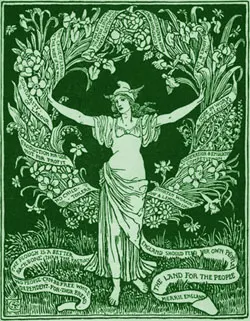What are the Origins of May Day - Rosa Luxemburg ( 5/3/1871 - 15/1/19)
Rosa Luxemburg
' The happy idea of using a proletarian holiday celebration as a means to attain the eight-hour day was first born in Australia. The workers there decided in 1856 to organise a day of complete stoppage together with meetings and entertainment as a demonstration in favour of the eight-hour day. The day of this celebration was to be April 21. At first, the Australian workers intended this only for the year 1856. But this first celebration had such a strong effect on the proletarian masses of Australia, enlivening them and leading to new agitation, that it was decided to repeat the celebration every year.
In fact, what could give the workers greater courage and faith in their own strength than a mass work stoppage which they had decided themselves? What could give more courage to the eternal slaves of the factories and the workshops than the mustering of their own troops? Thus, the idea of a proletarian celebration was quickly accepted and, from Australia, began to spread to other countries until finally it had conquered the whole proletarian world.
The first to follow the example of the Australian workers were the Americans. In 1886 they decided that May 1 should be the day of universal work stoppage. On this day 200,000 of them left their work and demanded the eight-hour day. Later, police and legal harassment prevented the workers for many years from repeating this (size) demonstration. However in 1888 they renewed their decision and decided that the next celebration would be May1, 1890.
In the meanwhile, the workers' movement in Europe had grown strong and animated. The most powerful expression of this movement occurred at the International Workers' Congress in 1889. At this Congress, attended by four hundred delegates, it was decided that the eight-hour day must be the first demand. Whereupon the delegate of the French unions, the worker Lavigne from Bordeaux, moved that this demand be expressed in all countries through a universal work stoppage. The delegate of the American workers called attention to the decision of his comrades to strike on May 1, 1890, and the Congress decided on this date for the universal proletarian celebration.
In this case, as thirty years before in Australia, the workers really thought only of a one-time demonstration. The Congress decided that the workers of all lands would demonstrate together for the eight-hour day on May 1, 1890. No one spoke of a repetition of the holiday for the next years. Naturally no one could predict the lightning-like way in which this idea would succeed and how quickly it would be adopted by the working classes. However, it was enough to celebrate the May Day simply one time in order that everyone understand and feel that May Day must be a yearly and continuing institution.
The first of May demanded the introduction of the eight-hour day. But even after this goal was reached, May Day was not given up. As long as the struggle of the workers' against the bourgeoisie and the ruling classes continues, as long as all demands are not met, May Day will be the yearly expression of these demands. And , when better days dawn, when the working class of the world has won its deliverance then too humanity will probably celebrate May Day in honour of the bitter struggles and the many sufferings of the past.'
1894
So today May Day, the 1st of May is now recognised all over the world as International Workers Day. It is a day for the working class to down tools and take to the streets in protest against capitalism and wage slavery. We should not forget Chigago , Haymarket either, where on May 4, 1886, demands for an eight hour working week became particularly intense. Where a demonstration largely staged by a group of anarchists, caused a crowd of some 1,500 people to gather. When policemen tried to disperse the meeting, a bomb exploded and the police opened fire on the crowd. More than 100 people were injured. Eight leading Chicago anarchists were subsequently arrested, and charged with the bombing, despite no evidence of their involvement, five were sentenced to be hanged, two were given life sentences and the last was sentenced to 15 years in prison. The trial is now known by legal historians as one of the worst miscarriages of American history.

In 1889 the congress of the Second International Workingman's association adopted a resolution to take up the fight for the 8 hour working day and to make 1st of May a worldwide day of protests in memory of the Haymarket martyrs, as they had become known.
The first British May Demonstration was held in the 1890's and in London alone, attracted 300,000 protestors in Hyde Park, and has continued to this day. Since then, May Day has become established as an annual event to commemorate all the workers who have died in the struggle against those who exploit them. A celebration of international struggles and our solidarity. Many today will remember the 400 plus who have died in the recent Bangladesh building collapse.With these acts of solidarity we also lay down the foundations of a future world. In Britain we even have a Bank holiday now close to the day, that the Tories have considered scrapping because of it's association, which thankfully has failed.
Today also marks a neo-pagan festival,Beltane, the Celtic festival of Summer's beginning a time to dance under a Maypole, a time of cleansing and renewal,drink and be merry, follow Jack in the Green, the mystical Green Man of legend.
I see no reason why not to celebrate all of the above.
Happy May Day
Heddwch/peace
A Garland for May Day
1895, Walter Crane
Remember the dead,
fight for the living.















